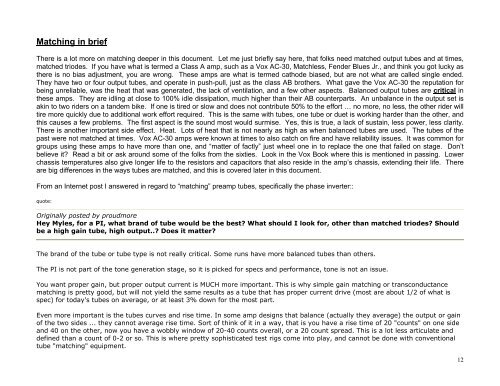a tube primer for guitar and bass players - Guitar Amplifier Blueprinting
a tube primer for guitar and bass players - Guitar Amplifier Blueprinting
a tube primer for guitar and bass players - Guitar Amplifier Blueprinting
You also want an ePaper? Increase the reach of your titles
YUMPU automatically turns print PDFs into web optimized ePapers that Google loves.
Matching in brief<br />
There is a lot more on matching deeper in this document. Let me just briefly say here, that folks need matched output <strong>tube</strong>s <strong>and</strong> at times,<br />
matched triodes. If you have what is termed a Class A amp, such as a Vox AC-30, Matchless, Fender Blues Jr., <strong>and</strong> think you got lucky as<br />
there is no bias adjustment, you are wrong. These amps are what is termed cathode biased, but are not what are called single ended.<br />
They have two or four output <strong>tube</strong>s, <strong>and</strong> operate in push-pull, just as the class AB brothers. What gave the Vox AC-30 the reputation <strong>for</strong><br />
being unreliable, was the heat that was generated, the lack of ventilation, <strong>and</strong> a few other aspects. Balanced output <strong>tube</strong>s are critical in<br />
these amps. They are idling at close to 100% idle dissipation, much higher than their AB counterparts. An unbalance in the output set is<br />
akin to two riders on a t<strong>and</strong>em bike. If one is tired or slow <strong>and</strong> does not contribute 50% to the ef<strong>for</strong>t … no more, no less, the other rider will<br />
tire more quickly due to additional work ef<strong>for</strong>t required. This is the same with <strong>tube</strong>s, one <strong>tube</strong> or duet is working harder than the other, <strong>and</strong><br />
this causes a few problems. The first aspect is the sound most would surmise. Yes, this is true, a lack of sustain, less power, less clarity.<br />
There is another important side effect. Heat. Lots of heat that is not nearly as high as when balanced <strong>tube</strong>s are used. The <strong>tube</strong>s of the<br />
past were not matched at times. Vox AC-30 amps were known at times to also catch on fire <strong>and</strong> have reliability issues. It was common <strong>for</strong><br />
groups using these amps to have more than one, <strong>and</strong> “matter of factly” just wheel one in to replace the one that failed on stage. Don’t<br />
believe it? Read a bit or ask around some of the folks from the sixties. Look in the Vox Book where this is mentioned in passing. Lower<br />
chassis temperatures also give longer life to the resistors <strong>and</strong> capacitors that also reside in the amp’s chassis, extending their life. There<br />
are big differences in the ways <strong>tube</strong>s are matched, <strong>and</strong> this is covered later in this document.<br />
From an Internet post I answered in regard to “matching” preamp <strong>tube</strong>s, specifically the phase inverter::<br />
quote:<br />
Originally posted by proudmore<br />
Hey Myles, <strong>for</strong> a PI, what br<strong>and</strong> of <strong>tube</strong> would be the best? What should I look <strong>for</strong>, other than matched triodes? Should<br />
be a high gain <strong>tube</strong>, high output..? Does it matter?<br />
The br<strong>and</strong> of the <strong>tube</strong> or <strong>tube</strong> type is not really critical. Some runs have more balanced <strong>tube</strong>s than others.<br />
The PI is not part of the tone generation stage, so it is picked <strong>for</strong> specs <strong>and</strong> per<strong>for</strong>mance, tone is not an issue.<br />
You want proper gain, but proper output current is MUCH more important. This is why simple gain matching or transconductance<br />
matching is pretty good, but will not yield the same results as a <strong>tube</strong> that has proper current drive (most are about 1/2 of what is<br />
spec) <strong>for</strong> today's <strong>tube</strong>s on average, or at least 3% down <strong>for</strong> the most part.<br />
Even more important is the <strong>tube</strong>s curves <strong>and</strong> rise time. In some amp designs that balance (actually they average) the output or gain<br />
of the two sides ... they cannot average rise time. Sort of think of it in a way, that is you have a rise time of 20 "counts" on one side<br />
<strong>and</strong> 40 on the other, now you have a wobbly window of 20-40 counts overall, or a 20 count spread. This is a lot less articulate <strong>and</strong><br />
defined than a count of 0-2 or so. This is where pretty sophisticated test rigs come into play, <strong>and</strong> cannot be done with conventional<br />
<strong>tube</strong> "matching" equipment.<br />
12



